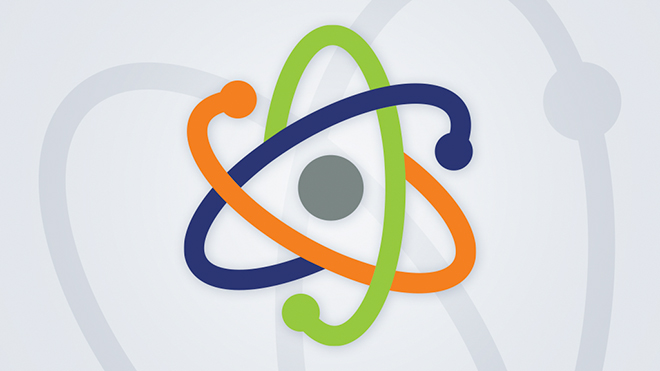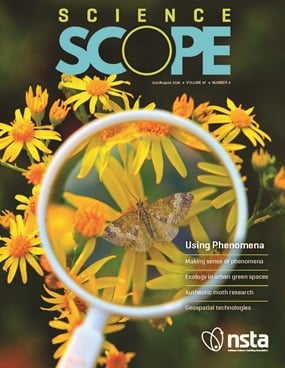All Resources
Workshop
Web Seminar
Lithium-ion (Li-ion) batteries have an increased presence in our school classrooms and laboratory instructional spaces, including cell phones, tablets, laptops, and equipment. However, Science/STEM teachers nationwide are forced to adopt and make use...
Journal Article
Cultivating Genius for Science Contexts: Where Does the Pursuit of Joy Fit into Science Learning?
Where do Goldy Muhammad’s Cultivating Genus Pursuits fit into science learning? In this article, 5th grade teachers are adding the pursuits into a FreshWater project based science unit. Focusing on Identity and Joy, in particular, they find that sc...
By Alice Severson, Leigh Kohlmann, Emily Miller, Kevin Anderson
Journal Article
Leading Effective Science Curriculum-Based Learning
Leadership Matters...
By Patrick Brown, Rodger W Bybee, Joseph Taylor
Journal Article
Light, Forces, Sticks, Crates and So Much More: A Loose Parts Learning Approach to STEM
The use of loose parts can be an effective teaching method to improve and enhance student understanding of Next Generation Science Standards (NGSS). Loose parts can inspire children to use their creativity and critical thinking skills in the classroo...
By Carla Gull, Suzanne Levenson Goldstein, Tricia Rosengarten
Journal Article
Beyond Definitions: Using Hexagonal Thinking for Sensemaking
This article was written for the purpose of introducing the hexagonal thinking strategy to upper elementary teachers. The strategy, in which students make connections across the vocabulary and concepts to develop a map, has become more popular in the...
By Simone Nance
Journal Article
Engaging in Socioscientific Issues by Observing Habitats in the Context of Water Use and Drought
Teaching young students to engage in socioscientific reasoning can feel like an overwhelming task due to the abstract reasoning required. Yet, Sadler et al., (2007), note the importance of helping students develop socioscientific reasoning from a you...
By Grace Brunner, Catherine Lowe, Isaiah Kent-Schneider, Jerrid Kruse
Journal Article
Summertime fun with Life Science!
In this issue of Tech Talk, learn about two terrific life science apps, Rewild the World from Google Arts and Culture and Explore.org. Engage your learners in NGSS Science and Engineering practices of Developing and Using Models and Asking Questions ...
By Heather Pacheco-Guffrey
Journal Article
Science 101...
By Matthew Bobrowsky
Journal Article
Scaffolding Fourth-graders’ Inquiry about Erosion
This sequence of lessons has students observing erosion and creating ideas about factors that affect erosion. Then, as a class, students first explore the impact of vegetation on erosion. Then, groups of students more independently investigate the im...
By Alexandria Burns, Jami Daniel, Jerrid Kruse, Ellen Gow
Journal Article
This article presents a tool that teachers can use to support children in planning science investigations. Using an extended example from a second-grade investigation into seed dispersal, we describe strategies for structuring conversations that anch...
By Annabel Stoler, Eve Manz
Journal Article
Formative Assessment From a Translanguaging Perspective in the NGSS Classroom
The Next Generation Science Standards hold promise for cultivating the diverse assets that students bring to science learning. One key asset in linguistically diverse science classrooms is translanguaging, or the use of one’s full communicative rep...
By Abigail Schwenger, Scott Grapin, Nicole Altamirano, Alison Haas, Okhee Lee
Journal Article
I CAN: Strategies for Rethinking How We Share Objectives
Teachers are often required to display or explicitly state learning objectives prior to beginning a lesson. In particular, many elementary classrooms are required to post or state “I CAN…” statements related to their standards. Unfortunately, t...
By Julianne Wenner, Brooke Whitworth
Journal Article
Smart Telescope technology and its suggested use for the Science classroom....
By Bob Riddle
Journal Article
Finding Instructional Resources for Teaching about Scientific Misinformation
Commentary...
By Andy Zucker
Journal Article
Conducting authentic moth research with students to encourage scientific inquiry.
Studying moths is an excellent way to include students in science practices by introducing them to a ubiquitous but under-appreciated animal group that can be found in their local places, including urban, suburban, agricultural, forested, and other h...
By Brian Keas, Peter White, Christopher Brown, David Stroupe, Sara Best, M. LeTarte
Journal Article
The Framework and NGSS emphasize using lines of evidence to construct explanations and develop arguments that demonstrate understanding about scientific phenomena. For this vision to be actualized in science classrooms, students must engage in invest...
By Kenneth Huff
Journal Article
Loud and Clear Project: An Introduction to Geospatial Tools for Project-Based Learning
Project-based and student-driven learning continue to be at the forefront of school reform efforts. Technology is a significant bridge and tool used empower and leverage student projects. Geospatial technologies continue to be underutilised in the mi...
By Kurtz Miller
Journal Article
Using Local Phenomena to Support Student Learning
Research on science teaching and learning supports instructional sequences that are driven by phenomenon, provide student-agency, and are made relevant to students. The use of locally-based, phenomenon-driven instruction that creates opportunities fo...
By Martha Inouye, Clare Gunshenan, Amanda Lopez
Journal Article
In this article, we use the strategies listed above to engage students in a 5E lesson on static electricity (partially addressing MS-PS2-3). We start the engage phase by using a “magic trick” as a hook to engage students about static electricity....
By Jesse Wilcox, Stephanie Zavalza Flores, MacKenzie Bruns, Sarah Nolting
Journal Article
Ecology in Urban Spaces: Contributions of Urban Green Spaces to Ecological and Community Health
Our program seeks to introduce middle school students to a range of STEM topics and careers. We planned and enacted a five-lesson unit themed around the contributions of trees/green spaces to ecological and community health. Humans thrive in ecologic...
By Yelena Janumyan, Zachary Conley, Heidi Carlone, Hannah Ziegler, Tessaly Jen, Liwei Zhang, Jingyi Chen
Journal Article
Summer Science with the Secchi Dip-In Project
Secchi Dip-In citizen science project for Science Scope...
By Jill Nugent
Journal Article
Communicating With Data Around Phenomena (Data Literacy 101)
Helping our students make sense of data while they are working with phenomenon can be an excellent way for students to build critical 21st-century data skills in engaging and authentic ways. Here I outline an instructional strategy we can use when in...
By Kristin Hunter-Thomson
Journal Article
Exploring the Favorites in Science Education Issue
Editor's Corner...
By Ann Haley Mackenzie
Journal Article
Teaching about the Critical Role of Key Scientific Institutions
Fact or Faux?...
By Andy Zucker, Jocelyn Miller
Journal Article
Geology from a Beaker: Student Activities in Earth Science
Student activities based on deposition in a beaker introduce Walther’s Law, which states that, if uninterrupted, vertical deposition is duplicated in the horizontal. When gravel, sand, and clay (mud) are stirred in a beaker of water, they settle ou...
By Jr. Miller
Journal Article
This article discusses an innovative approach to science education focused on engaging students through authentic learning experiences and hands-on activities. It emphasizes the importance of linking classroom instruction with real-world science rese...
By Ashley Booker, Katherine Eaton
Journal Article
Blockbuster Science: Checking our positions
Media has always played a significant role in shaping education. Visual cues and observable phenomena brought to life on screens or through vivid and engrossing sound effects make science accessible to people in ways that textbooks, journals and tech...
By Joy Barnes-Johnson
Journal Article
Finding Zero: Exploring Mathematical Models with Pendulum Paintings
Pendulum paintings are fun to make and fascinating to observe in process, but they can be used to model real scientific analysis using messy data. In this activity, students create pendulum paintings and develop an analysis using measurements of mult...
By Daniel McKinney
Journal Article
Going Beneath the Surface: Using Socioscientific Issues to Explore Human Impacts on Soil
Socioscientific issues (SSIs) can help students think about the moral and ethical issues related to science. When SSI issues are based on local phenomena and issues within students’ communities, they can also resonate more with students....
By Jesse Wilcox, William Lange, Shane Breheny
Journal Article
Local landscapes examined via Google Earth provide a natural arena on which students can analyze how humans modify and interact with their environment. These lessons guide students through an exploration of the natural and built environments both nea...
By Carol Colaninno, Adriana Martinez, Charlie Blake, Candice Johnson
Journal Article
Globalizing STEM Instruction Using Sustainable Development Goals
Global education presents an opportunity for all classroom teachers, regardless of subject or grade level, to engage students in understanding globally relevant issues that extend from content taught in class and providing opportunities for students ...
By George Hademenos
Journal Article
In this unit, students explore the phylogeography of three-toed sloths (Bradypus pygmaeus and Bradypus variegatus) endemic to the Bocas del Toro islands off the Caribbean coast of Panama. After learning about the geologic history of this region, stu...
By Tyler St. Clair, Kristen Conklin-Kearney
Journal Article
Helping Students Use Crosscutting Concepts to Guide Sensemaking of Anchoring Phenomena
Crosscutting concepts (CCCs) are designed to help students make sense of phenomena across multiple scientific disciplines (National Research Council 2012). Since they are applicable to explaining so many different phenomena, they have the potential t...
By Nicole Vick, Michael Novak, Dan Voss, Brian Reiser, Joseph Kremer, Whitney Mills, Jamie Noll, Dawn Novak, Ann Rivet
Journal





